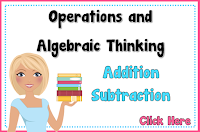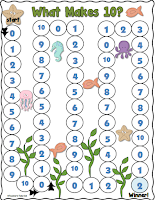How many of your students use their fingers to add numbers? I have some basic tips that will guide your students in the right direction to master addition skills so they will not use their fingers to add numbers. Students should master each step before moving on to the next step. The goal is to help students see numbers in a different way which will help them think about the numbers instead of counting on their fingers.
Here are the steps that will help students become proficient!
First, teach the numbers that make 10. For example: 1+9, 2+8, 3+7, 4+6, and 5+5. Students should be able to recognize these pairs of numbers instantly. This will help them later on too. If students know that 3+7=10, then later on they would know that 30+70=100. Plus, our place value system is based on tens. Students need to proficiently know these pairs that make 10. If you need extra practice, try this pack of making 10.
Here is a FREE game to learn the combinations or pairs of 10. This is a great game to help memorize the pairs. Just click the picture on the left to download this free game.
Next, teach adding a 10 to a number. For example; 3+10. This should be done with no thinking. Counting by 10's from any number is essential! They should NOT be counting 10 more on their fingers. This needs to be automatic. They should be able to count by 10's going forward and backwards from any number. Students should also be proficient at counting 1 more and 1 less from any number. Here is a FREE resource to help with adding and subtracting by 1's and 10's.


Then, teach adding a 9 to a number. For example: 3+9. If they know how to add 10, they can add a 9 with little thinking. If you add 1 more to the 9 to make a 10, then you would know that 3+10=13. But we need to subtract 1 from 13 because we added the 1 to make a 10. Adding 9 to any number will help exercise the brain moving forward and backwards by 1 on a number line. Most students need help seeing the 9 in the equation. Sometimes they sit and stare at the addition fact with a blank stare until I say, "I see a 9." Then right away they know what to do. It's training the brain to see the 9 and connecting it with a trick they know. If you know how to add 10, then you can add 9 with ease.

After, teach the doubles. For example: 5+5 or 6+6. Students should know their doubles without thinking. They should not be adding on their fingers a double. These need to be memorized. Doubles come in handy when thinking about other addition facts. Doubles also help when learning multiplication. Know those doubles! They should also recognize the subtraction fact family of a double too. If they know that 6+6=12, then they should begin to recognize that 12-6=6. Students can do a lot when they know their doubles.
After you teach the doubles, you can work on doubles +1. For example: 6+7. Some people like to call these numbers, neighbors, because they are neighbors or next door to each other on the number line. For this addition fact, you can see 6 and 7 are neighbors on the number line. If you see a neighbor, you take the smallest number, double it, and add 1 more.

Finally, students should be proficient in adding 2 more or 3 more to a number. They should already know how to add 1 more with ease. Adding another 1 is simple.
As students become proficient, they will begin learning tricks and seeing numbers differently. Their brain learns to look for combinations and pairs and connecting it with what they know. Then they will begin using a strategy other than their fingers.
When they get to a fact like 4+7, they may think, "I know that 3+7 is 10, therefore 4+7 must be 11." or they may think, "I know that 4+4 is 8, therefore 3 more make 11." Or they may think, "I know that 4+6=10, then 1 more would make 11." These 3 examples use strategies other than fingers.
The best way to learn these strategies is to practice, practice, and practice. We can't be good at something if we don't practice. Right?
Here are some fun resources that will help master addition facts and to practice the strategies listed above.
Here are some more ideas to use when teaching to master facts. All ideas are found on Amazon:
Addition Facts that Stick
Self Correcting Addition Keys
Addition Chart
I hope these tips are helpful in mastering addition facts.
See you soon,
Click the picture below to find more addition and subtraction resources:
 Stay tuned to my next blog post:
Stay tuned to my next blog post:
2.OA.2
loading..












































































Is this a good place to start for kindergarteners?? Or should this be more geared towards first graders?
ReplyDeleteThis app brings exciting casino-style and skill-based games, smooth payments, and multiple reward programs that make it stand out. Let’s explore everything you need to know about PAK365 Game, including how to download, deposit, withdraw, earn bonuses, and more.
Deletehttps://stargame.com.pk/download/
I think the earlier the better. Start simple with facts of 10.
ReplyDeleteaw
ReplyDeleteTeachers should give full attention to the students to improve their reading ability so that most of the students may read their lesson without using finger. I appreciate you to introduce this topic which is very useful for a reader. dissertation writing service
ReplyDeletemy students bite
DeleteThis comment has been removed by the author.
DeleteThis comment has been removed by the author.
ReplyDeleteIf you have some fun video, you can post it on tiktok and buy tiktok likes from this source https://soclikes.com/buy-tiktok-likes
ReplyDeleteI consider this to be information of quality and it appears to be written so as to make the reader think. I like your writing style and appreciate your efforts. Providing Canadian Student Allocation Assistance is something we do best. With the help of the online assignment writing help Canada aid and the assistance we provide is very important to us as we know the fast paced life of the city's students, arguing between academics and their part-time jobs to make a living.
ReplyDeleteDownload Golds bet Gaming Application
DeleteThese tips are amazing. This will surely help me out in making the easiest way to child's studies. Getting an expert for your child is good and luckily I am connected to affordable assignment writing services for securing my child's academic year.
ReplyDeleteLOL THAT MF CAN'T COUNT LOLOL
DeleteYour information is really awesome as well as excellent and I got more interesting information from your blog. Assignment Help UK
ReplyDeleteAwesome post! If you share smth similar on social media, you can use Krootez services to show higher engagement on your content. Just follow this link for more likes: https://krootez.com/buy-instagram-likes/
ReplyDeleteWonderful article. Fascinating to read. I love to read such an excellent article. Thanks! It has made my task more and extra easy. Keep rocking. read more
ReplyDeleteThe assignment submission period was over and I was nervous, 온라인사이트 and I am very happy to see your post just in time and it was a great help. Thank you ! Leave your blog address below. Please visit me anytime.
ReplyDeleteThanks for the blog very nice keep going.
ReplyDeletehome mobile phone repairs
Nice blog! click here for refurb iphone se 2020
ReplyDeleteExcellent Blog! I would like to thank for the efforts you have made in writing this post.
ReplyDeleteTikTok is a social media platform that allows users to create and share short videos with others. The videos are typically 15 seconds or less, and they can be about anything that interests the user. TikTok has become extremely popular in recent years, and it is now one of the most downloaded apps in the world. Buy 4000 watch hours and 1000 subscribers
ReplyDeleteYour article is well written and simple to understand.You make excellent points.Thank you for sharing amazing blog.Nice.....
ReplyDeleteI love that 3 Patti World offers so many variations of the classic Teen Patti game. It keeps things interesting and fresh. My only complaint is that sometimes the app can be a bit slow to load during peak hours, but overall, it’s a fantastic platform! download latest version
ReplyDeleteIt offers fantastic advice for students and is amazing beneficial to educators. Teachers should implement these innovative teaching methods in the classroom. With the assistance of Assignment Writing Services UK, I recently completed my thesis assignments, and I sincerely appreciate you sharing these suggestions.
ReplyDelete